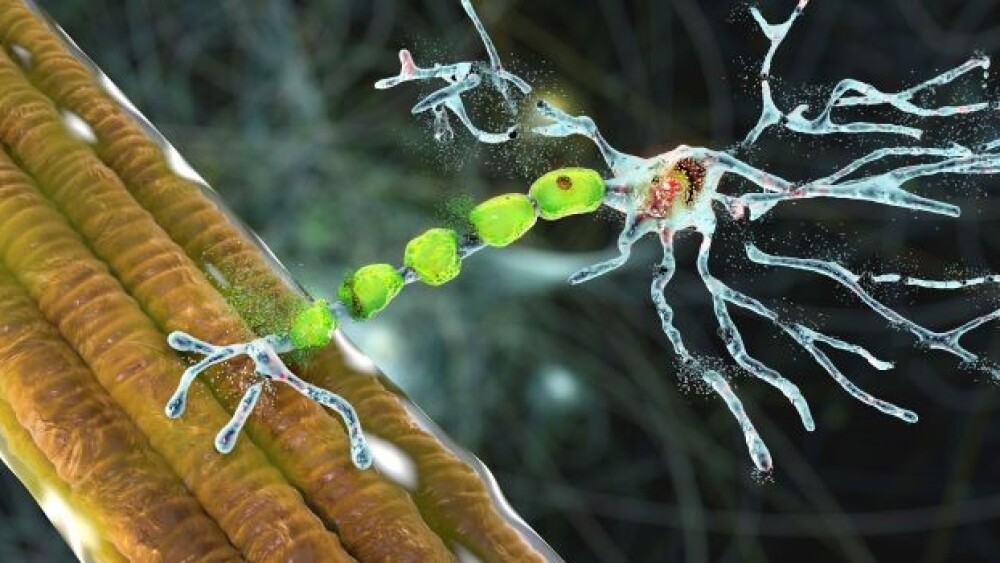Phase IIa data showed AI Therapeutics’ ALS candidate increased expression of a target engagement biomarker and led to a 73% reduction in a toxic protein aggregate.
Pictured: Degradation of motor neurons, conceptual 3D illustration / iStock, Dr_Microbe
After Cytokinetics reported a Phase III failure in ALS this week, Wednesday brought a spark of good news to the space. Little-known biopharma company AI Therapeutics announced positive data from its Phase IIa clinical trial in patients with a C9orf72 mutation.
Results of the Phase IIa study showed AIT-101 increased expression of a target engagement biomarker, sGPNMB, and led to a 73% reduction in poly(GP), a toxic protein aggregate, over 12 weeks. AIT-101 also met the study’s primary endpoints of safety and tolerability and confirmed penetration of the blood brain barrier.
AI CEO Brigette Roberts expressed excitement with the results and said AI will move the asset forward “expeditiously” into the next phase of clinical development.
This small, biomarker-driven study focused on a specific mutation of ALS and was based on the ability to clearly measure poly(GP). The C9orf72 mutation is present in 40–50% of familial ALS cases and 5–10% of sporadic ALS patients.
The next trial will be much larger, focused on functional endpoints and include a much broader ALS population, Roberts said.
AIT-101 is the first PIKfyve kinase inhibitor with clinical data for ALS, Roberts told BioSpace. Inhibiting the PIKfyve kinase leads to the activation of transcription factor TFEB, according to AI. This activation facilitates increased clearing of the toxic protein aggregates in motor neurons, a hallmark of ALS.
Depletion of TFEB in neural tissues is a characteristic found in many neurodegenerative diseases, including ALS, Alzheimer’s, Huntington’s, Parkinson’s and frontotemporal dementia.
AIT-101 could have broad applicability across multiple forms of ALS and showed efficacy in a recent TDP-43 animal model of ALS, according to the announcement. Mutations to TDP-43 are associated with both familial and sporadic cases of ALS and found in the brains of Alzheimer’s patients as well.
Detailed results of the Phase IIa study will be presented at a future medical congress.
In a statement e-mailed to BioSpace, Merit Cudkowicz, chief of the Neurology Department at Massachusetts General Hospital, said the trial is a great example of how to do early studies in ALS, ones that show target engagement at dose, assess safety and inform the next pivotal study.
Hits and Misses in ALS
Approximately 5,000 people in the U.S. are diagnosed with ALS each year, but the disease has been a tough nut for drug developers to crack.
Earlier this month, Cytokinetics discontinued its Phase III COURAGE-ALS trial when reldesemtiv failed to significantly improve disease severity as measured by the ALSFRS-R scale compared to placebo in a planned interim analysis.
More positive news arrived Thursday when Cambridge-based QurAlis announced it has dosed the first patient in a Phase I trial of its first-in-class STATHMIN-2 precision therapy.
STATHMIN-2 is important for neural repair and axonal stability and the underlying gene is significantly regulated by TDP-43 in humans, Angela Genge, chief medical officer at QurAlis, said in the announcement. QurAlis intends to enroll 64 patients in the trial across Canada, the U.S. and parts of Europe.
“We are in a transition period in ALS where as we understand biology more, the treatments in trials are getting better and we will continue to have more successes,” Cudkowicz said.
Kate Goodwin is a freelance life science writer based in Des Moines, Iowa. She can be reached at kate.goodwin@biospace.com and on LinkedIn.






